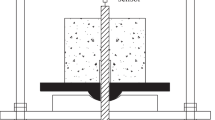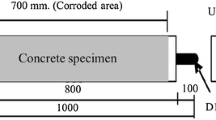Abstract
The tension stiffening effect of chemically prestressed concrete (CPC) under uniaxial tension was experimentally investigated and compared with those of reinforced concrete (RC). A special specimen profile was designed to avoid the effect from end parts. The tension stiffening of both RC and CPC were compared with the current tension stiffening model. The crack pattern was observed after loading. The results show that the CPC has superior tension stiffening than RC and the conventional model for RC substantially underestimates the tension stiffening of CPC. In addition, the number of cracks in CPC is less than in RC at the same load. Further investigation on bonding characteristics of CPC under tension was subsequently conducted. Effects of cross section’s size and amount of expansive additive were also investigated. The strain distribution of rebar was measured from strain gages attached with 20 mm interval. Local bond, slip and average bond stress were then calculated. The results show that bond of CPC near loading end is higher than that of RC, although the average bond is almost same. The results of this study can partly explain some of unique tensile properties of CPC which can be related to its cracking resistance.


























Similar content being viewed by others
References
JSCE (1994) Practice for expansive concrete recommended by JSCE committee. Concrete Library International, no 23, pp 5–9
Japanese Standard Association, JIS A 6202 (1997) Expansive additive for concrete
Okamura H, Tsuji Y, Maruyama K (1978) Application of expansive concrete in structural elements. Reprinted from J Fac Eng Univ Tokyo B 34(3)
Ishimura T, Maruyama T, Hosoda A, Kishi T (2001) Behavior of expansive concrete under tensile stress including tension stiffening. In: Proceedings of the eight EASEC conference, Singapore, paper no. 1273
Hosoda A (2001) Crack resistance and post cracking behavior of expansive concrete based on microscopic mechanism and application to RC members. Doctoral dissertation, The University of Tokyo (in Japanese)
Sahamitmongkol R, Kishi T (2003) The effect of restrained level on cracking resistance for chemically prestressed reinforced concrete. In: Proceedings of JCI annual conference, vol 25, no 2, pp 763–768
Belabi A, Hsu TTC (1994) Constitutive laws of concrete in tension and reinforcing bar stiffened by concrete. ACI Struct J 91:465–474
Okamura H, Maekawa K, Sivasubramaniyam S (1985) Verification of modeling for reinforced concrete finite element, finite element analysis of reinforced concrete structures. In: ASCE, pp 528–543
Bischoff PH (2001) Effect of shrinkage on tension stiffening and cracking in reinforced concrete. Can J Civ Eng 28:363–374
Sato R, Masaki S, Hiramatsu Y, Kodama K (2003) Serviceability performance evaluation of reinforced high strength concrete beams. In: The 2nd international specialty conference on the conceptual approach to structural design, Cl-Premier, Italy, pp 763–770
Choi KY (2003) Deformational behavior of RC tension member subjected to coupled thermo-mechanical actions. Dissertation, Department of Civil Engineering, The University of Tokyo
Lam NT, Sahamitmongkol R, Tangtermsirikul S (2008) Expansion and compressive strength of concrete with expansive additive. Res Dev J Eng Inst Thail 19(2):40–49
Salem HM (1998) Enhanced tension stiffening model and application to nonlinear dynamic analysis of reinforced concrete. A dissertation for the Doctor of Philosophy, The University of Tokyo
Salem HM, Maekawa K (1997) Tension stiffening modeling for cracked reinforced concrete derived from micro-bond characteristics. In: Proceedings of JCI annual conference, vol 19, no 2, pp 549–554
Floegl H, Mang HA (1982) Tension stiffening concept based on bond slip. In: Proceedings of the American Society of Civil Engineers, ASCE, vol 108, no ST12, December
Shima H, Chou L, Okamura H (1987) Micro and macro models for bond in reinforced concrete. J Fac Eng Univ Tokyo XXXIX(2):133–194
Salem HM, Hauke B, Maekawa K (1998) Concrete cover effect on tension stiffness of cracked reinforced concrete. In: Proceedings of JCI annual conference, vol 20, no 3
Sahamitmongkol R (2005) Microscopic mechanism and influencing factors on cracking resistance of chemically prestressed concrete member. Dissertation, Department of Civil Engineering, The University of Tokyo
Goto Y (1971) Cracks formed in concrete around deformed tension bars. ACI J 68:244–251
Sahamitmongkol R, Kishi T (2005) Internal damage of reinforced concrete and chemically prestressed concrete under uniaxial load. In: The fourth international symposium on new technologies for urban safety of mega cities in Asia, Nanyang Technological University, Singapore, pp 139–146
Abrishami HH, Mitchell D (1996) Influence of splitting cracks on tension stiffening. ACI Struct J 93(6):703–710
Author information
Authors and Affiliations
Corresponding author
Rights and permissions
About this article
Cite this article
Sahamitmongkol, R., Kishi, T. Tension stiffening effect and bonding characteristics of chemically prestressed concrete under tension. Mater Struct 44, 455–474 (2011). https://doi.org/10.1617/s11527-010-9641-5
Received:
Accepted:
Published:
Issue Date:
DOI: https://doi.org/10.1617/s11527-010-9641-5




